|
 Hands On Physics Hands On Physics
The Great Bungee Jump
Concepts
CAPACITORS
|
Background: The role of the capacitor.
You will use an electronic component called a capacitor to make the
timer. Since a capacitor is an important electronic component, this is as
good a time as any to get to know it. This activity will give you an idea
of what a capacitor does.
A capacitor stores electricity. If you pump electrical current into it,
the capacitor develops a voltage that exerts a force that resists additional
current. In this experiment, you will use a hand crank that pumps current
into very large capacitors. These capacitors are constructed such that for
each Coulomb of charge you pump in it will push back with one volt. These
capacitors are a lot like rechargable batteries. The big difference between
batteries and capacitors is that a battery supplies a nearly constant voltage,
whereas a capacitor works at all voltages up to its maximum safe rating.
As you charge the capaictors with the hand cranked generator you can actually
feel the capacitor "filling up."
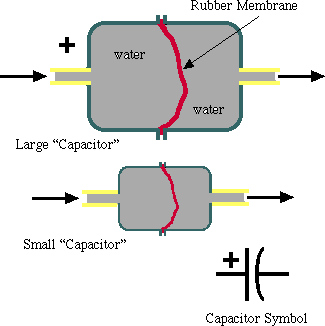
Figure P6
Capacitors as Tanks
A capacitor is like a closed water tank with two inlets separated by
a rubber membrane. The more water (charge) you pump in one inlet (wire),
the more back pressure (voltage) will build up. The pressure (voltage) opposes
the addition of more water (charge). So, the more water (charge) you add
the harder it gets to add more. Also note that whatever water (charge) flows
in one inlet (wire), the same amount of water (charge) comes out the other.
But because of the membrane, no steady water flow (current) can be maintained
through the tank (capacitor). A large tank (capacitor) can absorb a lot
of water (charge) before generating a large back pressure (voltage). We
could measure the capacity of a tank (capacitor) as the ratio of water volume
to pressure (charge to voltage, which is the definition of a farad).
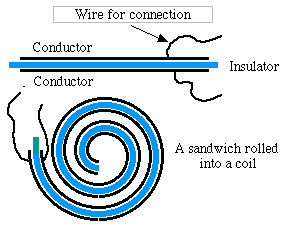
Figure P7
Capacitor Construction
A capacitor consists of two conducting sheets separated by an insulator.
The sheets are usually wound up into a spiral. You get more capacity by
increasing the area of the sheets and decreasing the thickness of the insulation.
You can make a good capacitor with aluminum foil separated by plastic wrap.
Try interleaving the layers as shown below.
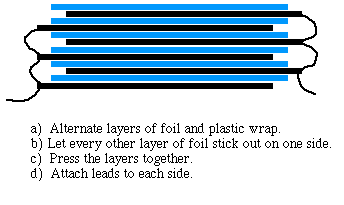
Figure P8
Making a Capacitor
Capacitors come in many different forms. Here are what different ones
look like:
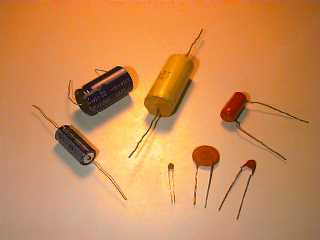
Figure P9
Kinds of Caps
The physical size of the capacitor is not a good guide to its electrical
capacity. There are two things to remember:
- Breakdown voltage. All capacitors will fail if you try to put
too much voltage across them. This is like the rubber membrane breaking
if you put too much pressure across it. To get a larger breakdown voltage
the physical size of the capacitor must be larger.
- Electrolytic capacitors. One way to make large capacitors is
to chemically create a very thin insulator on a metal. This is what is done
inside so-called electrolytic capacitors. The disadvantage of this approach
is that the thin insulation will disolve if you put the wrong sign of voltage
on it. These capacitors must always have one electrode more positive than
the other. Their leads are marked with a "+" and "p;".
Be sure to never reverse these.
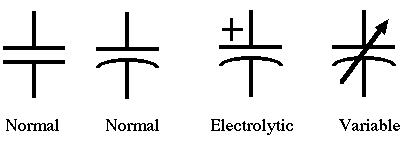
Figure P10
Capacitor Symbols
These are the electrical symbols for capacitors. The plus sign indicates
an electrolytic capacitor. There is no difference between the ones with
two straight plates and those with one curved plate.
Every capacitor leaks a little bit. Put charge in it and the charge will
slowly leak away. Expensive capacitors, especially ones with fancy plastics
between their electrodes, are the best. The kind with the least leakage
uses Mylar. For our timer circuit, we need one of these low-leakage capacitors.
Previous Page || Up
a Level || Index || Next
Page